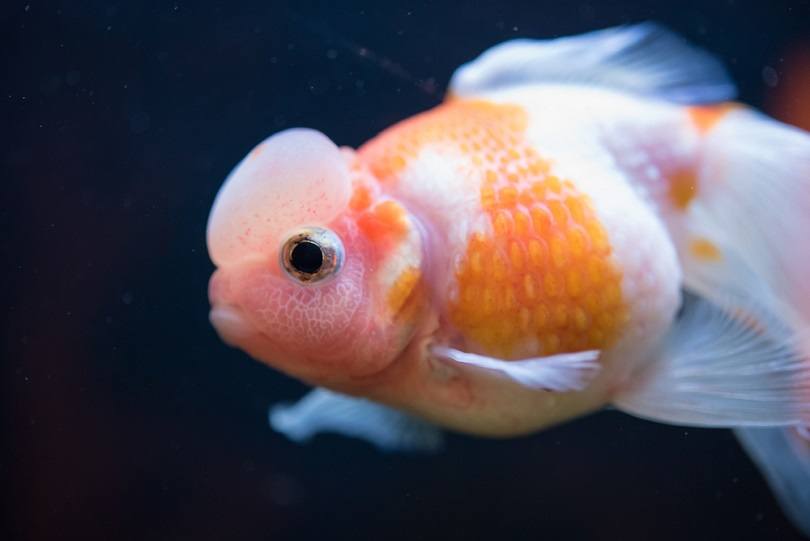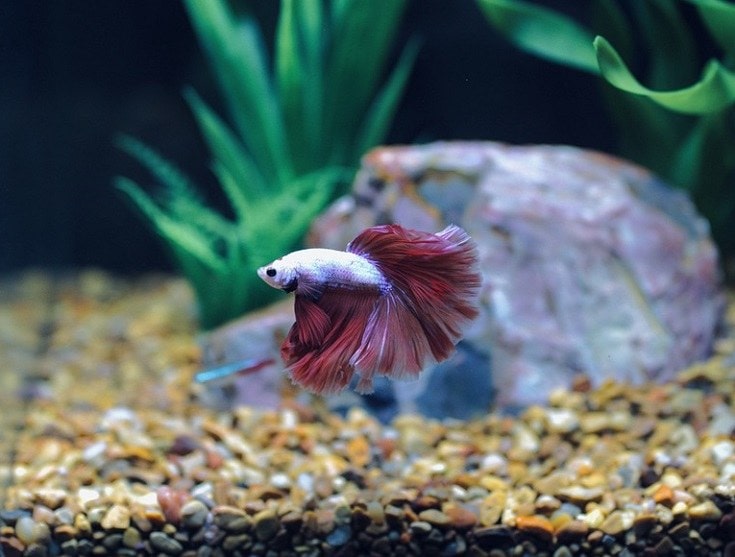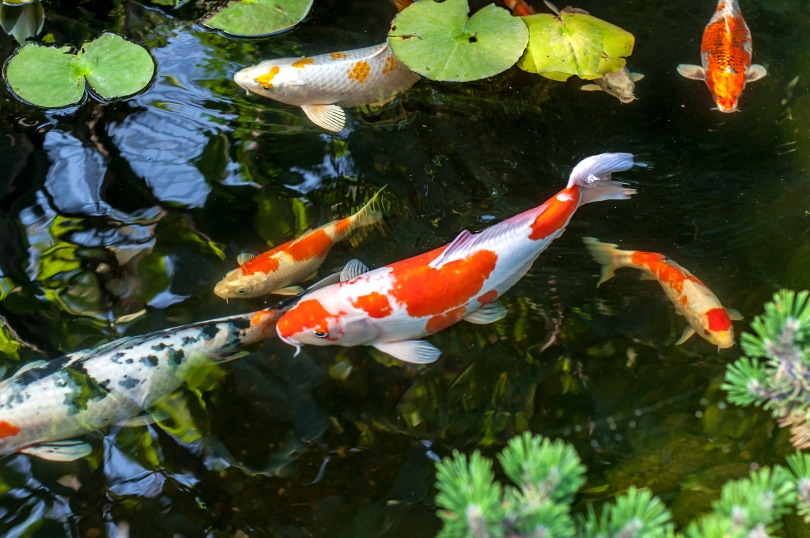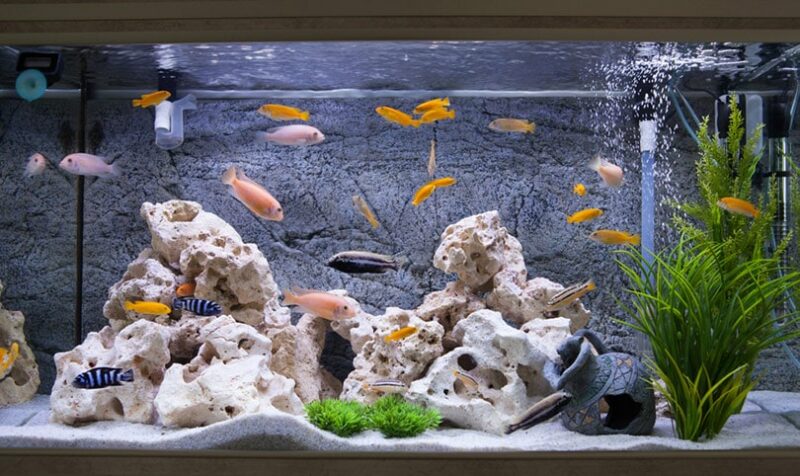
Click to Skip Ahead
Pearlscales are fancy goldfish that are considered relatively easy to care for and can even thrive in an outdoor pond in the right location. Pearlscale Goldfish have a unique look, thanks to their golf ball-like bellies and prominent belly scales that give the fish its name.
The Crown Pearlscale Goldfish takes this unique appearance even further, with a bubble-shaped crown on top of its head. They are also known as Hooded Pearlscales or High-Headed Pearlscales, are relatively common, and these freshwater fish are suitable for novice keepers.
Quick Facts about Crown Pearlscale Goldfish
| Species Name: | Crown Pearlscale Goldfish |
| Family: | Pearlscale Goldfish |
| Care Level: | Low |
| Temperature: | 65°F to 75°F |
| Temperament: | Placid |
| Color Form: | White, red, black, calico, chocolate |
| Lifespan: | 5–10 years |
| Size: | 6–10 inches |
| Diet: | Pellets or flakes |
| Minimum Tank Size: | 20 gallons |
| Tank Set-Up: | Sand, minimal decorations, plants, filter |
| Compatibility: | Other goldfish |
Crown Pearlscale Overview
The Crown Pearlscale Goldfish has a unique, almost comical, appearance. It is popular with beginner fishkeepers because it is relatively easy to care for but has this unique appearance that gives it pride of place in a tank, although Pearlscales can survive in outdoor ponds, too. They are relatively common, which makes finding them easy, and they prefer tanks with minimal decorations, although they do appreciate some plants to dart in and out of.
They are placid goldfish and do well when kept with other fancy goldfish varieties, although you do need to provide plenty of tank space for this species.

How Much Do Crown Pearlscale Cost?
Crown Pearlscales are a little less common than standard Pearlscales, but are still popular and, as a result, they are relatively easy to find in aquarium shops and through breeders. Because they are common, they are also inexpensive, costing around $10 to $25 per fish. You may be able to find them cheaper, especially if you are looking to buy multiple fish, or you may have to pay a little more if you go directly to a breeder.
Typical Behavior & Temperament
Placid and peaceful fish, Crown Pearlscales are also relatively slow swimmers, but that doesn’t mean they don’t enjoy exploring their surroundings, which means they do benefit from being given a decent size tank. They also benefit from having some plants to swim around, but their scales are quite delicate, so you need to avoid too many decorative items with sharp edges. They will get along with other placid fish and do especially well when kept with other species of fancy goldfish.
Appearance & Varieties
This fish has a rounded belly, that, in adults, can be almost perfectly spherical, giving Pearlscales the nicknames of “Golf Ball Goldfish” and “Ping Pong Goldfish.” They also have nacreous, or pearlescent scales, that form in perfect rows. The scales are actually formed from calcium carbonate and stand proud from the body. Finally, the Crown Pearlscale specifically has a bubble-shaped crown on top of its head. The crown can be single or double.
In terms of colors, the Crown Pearlscale can come in a wide variety of hues. Most commonly, the species is seen in solid white, red, or black but they can also be found in calico or chocolate, while gold and orange are also common.
The Crown is only one of several varieties of Pearlscale Goldfish. The Short-Tail Pearlscale is another common variety, with a shorter tail and a small head. It is a small Pearlscale variant but with a pronounced belly.
Expect a Crown Pearscale to grow to between 6 and 10 inches as an adult, but with optimal conditions, it is possible to have one grow to 11 or even 12 inches.

How to Take Care of Crown Pearlscale Goldfish
Crown Pearlscale Goldfish, like most Goldfish species, are relatively low maintenance, although the scales do add a little extra challenge. You will need a fairly sizable tank that is free from clutter, but the provision of healthy plants gives the Pearlscale opportunity to swim and adventure.
Habitat, Tank Conditions, & Setup
As well as adequate space in the tank, Pearlscales, like all fish, need optimal conditions to thrive. This means ensuring that the water is at a suitable temperature and pH level and that it remains clean. It also means the provision of suitable décor and plants.
Tank Size
A minimum of 20 gallons for a single Crown Pearlscale Goldfish is recommended, but an ideal size is 30 gallons for your first fish. For every additional Pearlscale, you should provide an extra 10 gallons of space. This means, for 3 or 4 of these unique fish, you will need a 50-gallon tank. If you can provide even more than this, your fish will enjoy the extra space, but they may look a little lost in too much space.
Water Quality & Conditions
In the wild, Goldfish live in slightly murky, slow-moving freshwater, and you need to try and replicate these conditions as closely as possible within your tank. The water should have a temperature between 65°F and 75°F and a pH between 6.5 and 7.5. Water hardness should be between 4 and 20.
Substrate
Although you can use a gravel substrate, the gravel should be large and smooth to prevent the fish from eating it. A better alternative for this species is sand, which more closely resembles their wild habitat and is safe for them to dig through.
Plants
To help emulate wild conditions, add some live plants to the tank. Ideal species include Java fern and Hornwort. Both of these plants will survive in relatively cold water conditions and they are hardy plants. Your goldfish may nibble on the Hornwort but will usually leave the Java fern alone.
Lighting
Goldfish benefit from light, but while too much light can kill them, too little light is unlikely to result in their demise. This means you don’t need to add artificial lighting to a tank, but you should ensure that the tank is situated in a spot where it does get natural light but is not in direct sunlight. The tank can do well near a window, but ideally not directly in the window.
Filtration
With no stomach, everything the Pearlscale Goldfish eats passes straight through it as waste, which means that the water can quickly become dirty, making a good quality filter an essential component to your tank setup. As well as good filtration, you will need to do partial water changes every week, typically replacing around a quarter of the water to help ensure the waste is removed and the water is clean.
Are Crown Pearlscale Goldfish Good Tank Mates?
Crown Pearlscale Goldfish are placid and are not aggressive fish. This means that they make excellent tank mates for any species. However, the double tail can be tempting to other species, and you should avoid keeping placid fish with aggressive bullies. Crown Pearlscale do well when kept together and they can also thrive in a community with other fancy goldfish varieties.
You will need to provide enough room for your community. If you are keeping multiple Crown Pearlscales, offer 20 to 30 gallons for the first fish plus 10 gallons for every additional fish that will live in the tank. Adjust this ratio if you will keep your Pearlscale with other species, but always err on the side of giving more space rather than less.
What to Feed Your Crown Pearlscale Goldfish
Pearlscales are omnivores that eat a combination of plant and animal matter. Feed dry pellets or flakes that are fortified with additional calcium. You can also offer additional plant and meat foods. Pearlscales will enjoy eating peas and small pieces of cucumber. Steam the vegetables before feeding, to get rid of any bacteria. You may also feed the occasional live food treats including brine shrimp and daphnia.

Keeping Your Crown Pearlscale Goldfish Healthy
Offer a good diet that consists of a high-quality pellet or flake. Feed steamed vegetables because these can help avoid constipation, and only offer live food as an occasional treat. Ensure that the protein you feed is no more than 30% of your goldfish’s overall diet. Pearlscales do like their water on the colder side, compared to a lot of other species, so you will need to control water temperature. And avoid putting too many pieces of tank décor that have sharp or hard edges, because these can lead to scale damage.
Breeding
Pearlscales can be prolific breeders if they are given the right tank conditions. Before breeding, separate the males and females. This will improve the likelihood of spawning when you reintroduce them. After a few weeks of separation, carefully release the males and females into the tank. Lower the water temperature to around 60°F and increase it by 3°F at a time until it reaches around 70°F. Feed more live food during this period and make partial water changes every day to maintain good water quality.
Are Crown Pearlscale Goldfish Suitable for Your Aquarium?
Crown Pearlscale Goldfish are relatively easy to care for and they have a unique, almost comical, look thanks to their rounded bellies and bubble-shaped crowns on their heads. Their pearlescent scales can be easily damaged, and they do prefer their water on the colder side, but if you can provide the right water conditions and keep tank décor to a minimum, you should enjoy keeping these intriguing fish.
Because they like colder water and can thrive in water that is a little on the murky side, they can even do well in some outdoor ponds, but you will need to consider the year-round climatic and environmental conditions before keeping any Pearlscale Goldfish outdoors.
Featured Image Credit: Vasin Srethaphakdi, Shutterstock










